Family : Nepenthaceae

Text © Prof. Pietro Pavone

English translation by Mario Beltramini
Nepenthes madagascariensis Poir. belonging to the family Nepenthaceae, is a tropical carnivorous plant endemic to Madagascar present on the eastern coast from Toamasina (Tamatave) to Fort-Dauphin. The most numerous populations are located in the District of Manakara (Region of Vatovavy-Fitovinany) and in the Reserve of Sainte-Luce (Fort Dauphin). Madagascar has many endemic species that differ considerably from the continental African ones, as a consequence of the isolation of the island that has broken away from the supercontinent of Gondwana about 140 million years ago.
Nepenthes madagascariensis lives in swampy marsh formations with poor drainage, formed by partly flooded peatlands. In these formations, at low altitude, we find a thick carpet of sphagnum (Sphagnum sp.) associated with the traveller’s palm (Ravenala madagascariensis Sonn.), with species of Pandanus, of Utricularia, of ferns (Gleichenia) and several Poaceae and Cyperaceae.
The southern part of the island is quite dry and the rain season begins in December and ends in April with a dry period from May to November, the temperature is mild all year round.
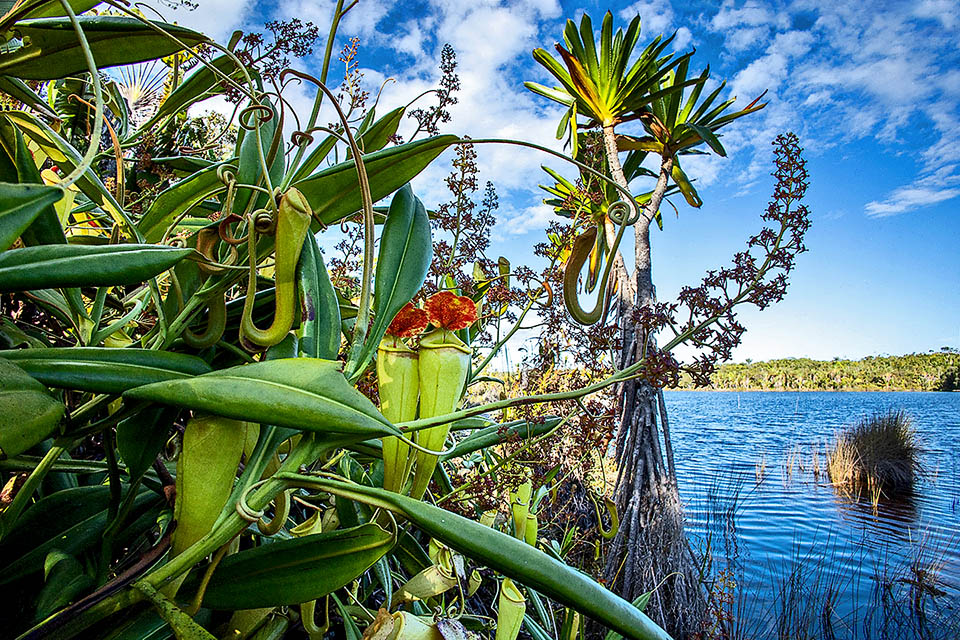
Often linked to swampy water streams and peat bogs, Nepenthes madagascariensis is endemic to eastern Madagascar. The environments where it lives are poor in nitrogen and gets it catching small animals with leaves transformed in aerial and basal wells, called ascidia, containing the digestive liquid secreted by the plant © Frank Deschandol
Near the city of Fort Dauphin, the populations of Nepenthes madagascariensis live in areas where the forests have been cleared by the cattle herders of the tribes Mahafaly who take their herds of zebu to graze on the scattered herbs that almost annually are set on fire.
These populations survive because they grow on north-facing ridges, and are thus spared from direct sun and the consequent drying effects.
However, the main threat to this species stands in the mining activity in the territory of the Tôlanaro, even if elsewhere the populations so far do not appear threatened.
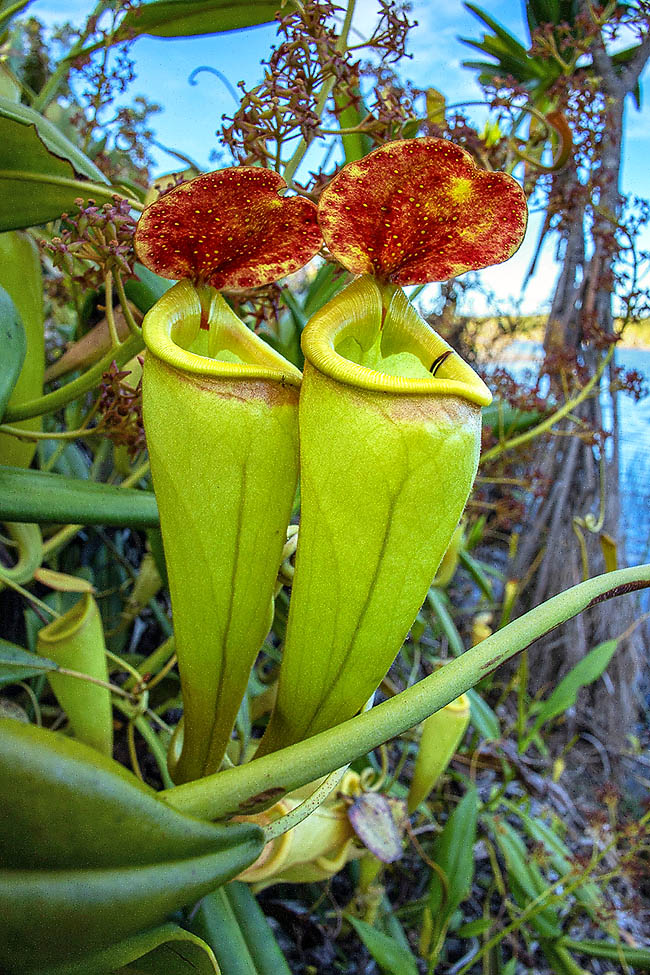
So as not to dilute it too much when it rains, ascidia have a lid. In the aerial ones of Nepenthes madagascariensis it’s red and rich in nectariferous glands on the lower side to attract the attention of flying insects © Frank Deschandol
As a consequence, this species is reported in the IUCN (International Union for the Conservation of Nature) Red List with least degree (LC, Least Concern) but is necessary the continuous monitoring of the populations, as the complete loss could lead to a rapid change of its conservation status.
Nepenthes madagascariensis is shown in the Appendix II of Washington Convention (CITES) that has the purpose of protecting the animal and vegetable species against the risk of extinction, forbidding their export and detention.
A karyological study has evidenced that this species has a chromosomal number 2n=80. It is possible that such a high number of chromosomes, present in all species of the studied Nepenthes, may be the result of a process of duplication of the genome (paleopolyploidy) occurred several million years ago with base number 8x or 16x.
The name of the genus Nepenthes comes from the adjective of the old Greek “νηπενθής”, (nipenthos), formed by the negative prefixνη, “nê, non”, and the name “πένθος”, (penthos) “sadness, pain”.
Adjective used by Homer to indicate the drink “nepenthes pharmakon” that Helen, furtively, has poured it into the wine that Teklemachus, son of Odysseus, and Menelaus, prince of Mycenae and her husband, were drinking in order to soothe, thanks to its effect of cancelling the memories, the pain and the nostalgia for their distance from their native country. The specific epithet refers to its origin area.
Nepenthes madagascariensis has been the first species of Nepenthes to be described in a printed work. To do it was the French Governor of Madagascar, Étienne de Flacourt (1607-1660) in his opus Histoire de la Grande Isle de Madagascar, printed in 1658, where he exposed the botanical characteristics of the plant, assigning her the name of Anramitaco, as was locally called.
In the chapter XXXVI of this work, in fact, we read: “Anramitaco is a plant growing about 3 feet high which carries at the ends of its leaves which are 7 inches long, a hollow flower or fruit, resembling a small vase, with its own lid, a wonderful sight There are red ones and yellow ones, the yellow being the biggest. The inhabitants of this country are reluctant to pick the flowers, saying that if somebody picks them in passing, it will not fail to rain that day. As to that, I and all the other Frenchmen did pick them, but it did not rain. After rain these flowers are full of water, and each one contains a good half-glass.”
More than a century later, this species was formally described as Nepenthes madagascariensis by Jean Louis Marie Poiret (1755-1834), French clergyman, botanist and explorer.
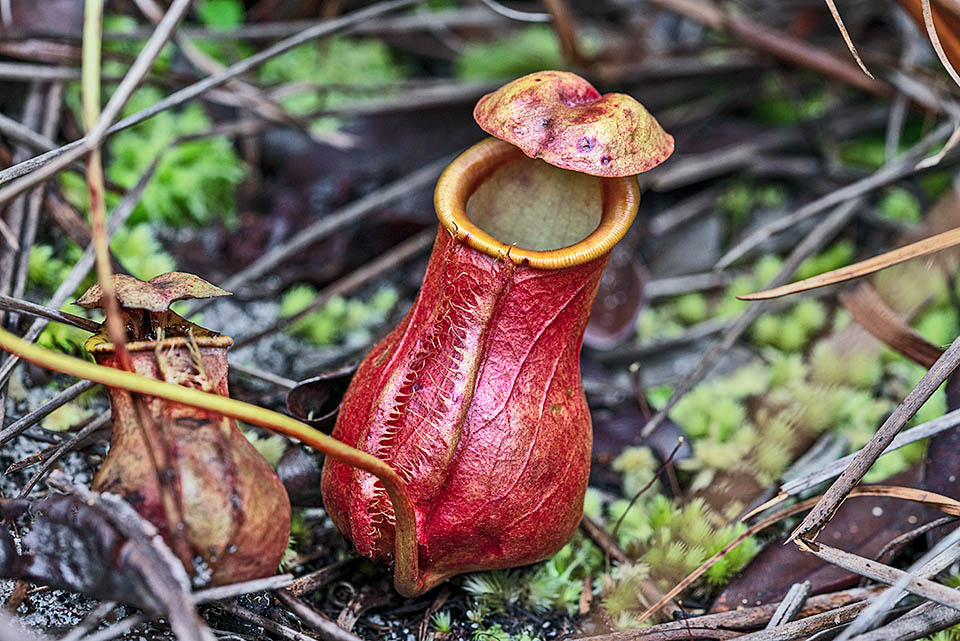
The basal ascidia, up to 14 cm and 5,5 cm broad, with the lower oval part variously swollen, instead catch the walking ones, mostly ants. To facilitate their climbing they have fringed formations, called wings, crossing the ascidium in its fore part. Totally, 94,3% of preys are ants (80,2%), diptera (9,7%) and beetles (4,4%) © Tom Ballinger
The description was published in J. B. Lamarck Encyclopedie Methodique Botanique – Paris 4(2): 459 1798. Poiret, in his accurate description, adds that it was the naturalist Philibert Commerson (1727-1773) who collected the plant in Madagascar and introduced it in France, so that male and female specimens are present in the herbal of Jean-Baptiste Lamarck (1744-1829), editor of the Encyclopedie. Poiret also reports the name that Flacourt gave to this plant (Anramitaco) changing it, by mistake, in Amramatico. This has caused, in the following quotations, quite a bit of confusion because the name changed depending from which publication it was pointed out. Other vernacular names are: Ponga, Andrahamitakona and Ampongandrano.
Nepenthes madagascariensis is a dioecious species, climbing, terrestrial, with an up to 1,5 m tall stem, or, if climbing, up to 9 m. The leaves have an attenuated base and the lamina is linear or elliptical, up to 28 cm long (rarely up to 40 cm), 8 cm broad, with 4-7 parallel veins. The petiole is winged, up to 5 cm long (rarely up to 12 cm), 1,5 cm broad, and wraps the stem completely or partially.
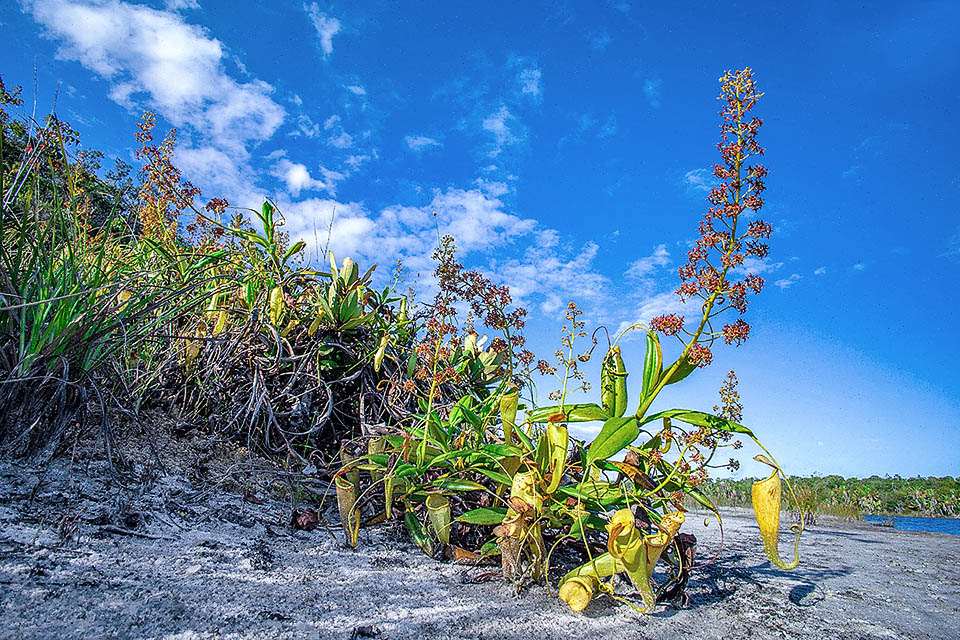
Dramatic blooming. The species is dioecious, that is the male and female flowers form on separate plants © Frank Deschandol
The lamina is green, whilst the central vein and the stem are yellowish or pale green. The stems are usually covered by short hairs. The petiole and the upper pagina of the leaf are glabrous whilst the lower one, the tendrils and the upper immature ascidia are covered by multicellular not ramified hairs. Hairs may be found on the lower edge of the cover of the ascidium probably to seal the opening during the growth. Very dense red-brown hairs are present on the youngest parts of the inflorescence excluding the column of the stamina that is wholly glabrous.
The flowers are actinomorphic and form on separate plants. The male ones, carried on short peduncles, are arranged on a long panicle-shaped inflorescence, ramified and terminal. They have four fleshy tepals of oval shape, reddish, with hairs covering the outer part. The stamina, merged in columns for the filaments, form, with the anthers, a sort of small white-yellowish sphere. The female flowers, also on a panicle-shaped long inflorescence, are carried by simple and uniforous peduncles. The tepals are four and of brown colour externally.
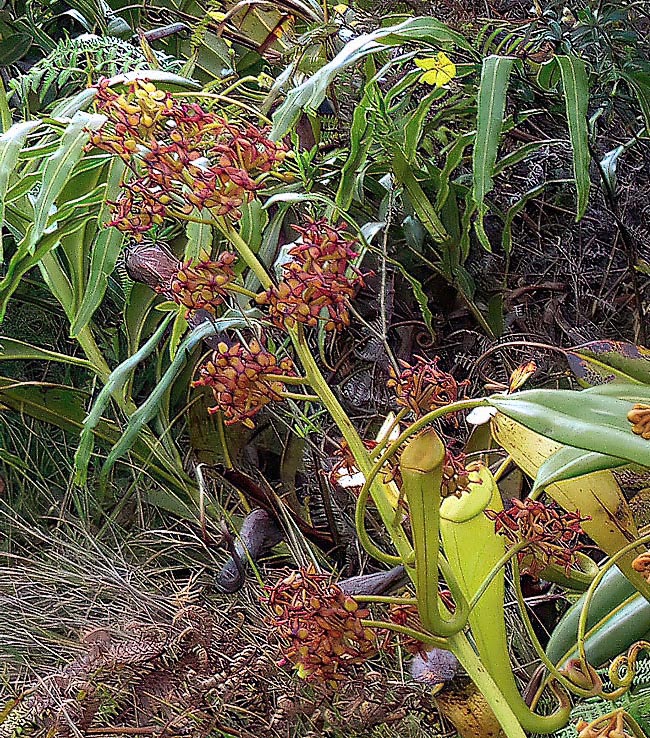
Male inflorescence. Flowers have 4 petals and the stamens, merged in column, form with the anthers a small sphere © Olivier Reilhes
The ovary is superior, formed by four merged carpels, with numerous ovules. The stigmata are arranged in a way to form a quadrilobed disc. Blooming occurs in spring. The fruits are capsules with four valves that open from top to bottom freeing many small elongated seeds, of brown colour. The median vein of the leaves extends to a tendril that widens at the apex to assume the shape of a cup, the so-called ascidium (from the Greek ἀσκίδιον,”small goatskin”), inside of which takes form a cavity representing the trap with which these plants catch their preys. This is an adaptation to the scarcity of nutritional resources, in particular to recover the nitrogen the plant cannot find at all in the environments it colonizes.
In Nepenthes madagascariensis are present basal or inferior ascdia and superior ones. The basal ascidia, up to 14 cm and 5,5 cm broad, have the oval lower half, variously swollen, to then narrow and widen at the opening. In order to facilitate the ascent of the preys, the basal ascidia have some formations, called wings, that travel through the ascidium in its fore part, up to 1 cm broad, fringed with up to 5 mm long filaments.
The peristome is up to 6 mm broad, and is covered by thin up to 0,4 mm high thin ribs, spaced up to 0,5 mm. The peristome has an orbicular, elliptical or ovate shape and has a constant width around the edge of the opening, but on the back side expands forming two short, up to 8 mm long, triangular growths. The lid, in its lower part, is dotted with numerous circular nectariferous glands of up to 3 mm of diameter. These glands secrete abundant nectar for attracting the insects who feed on it. The spur is up to 6 mm long and is not ramified. The outer side of the inferior ascidium is reddish or violet. The interior varies from pale pink to almost white and the peristome can be yellow, green, orange or red. Both sides of the cover have the same colour as the ascidium.
On the climbing stems get form the superior ascidia that usually are of pure and luminous yellow colour. They are strictly infundibular, up to 18 cm tall (rarely up to 25 cm) and 7 cm broad. The lower half of the ascidium is typically narrow. The wings are reduced to small crests, at times indiscernible. The peristome is up to 9 mm broad, and is covered by thin ribs up to 0,6 mm tall, spaced up to 0,5 mm apart from each other.
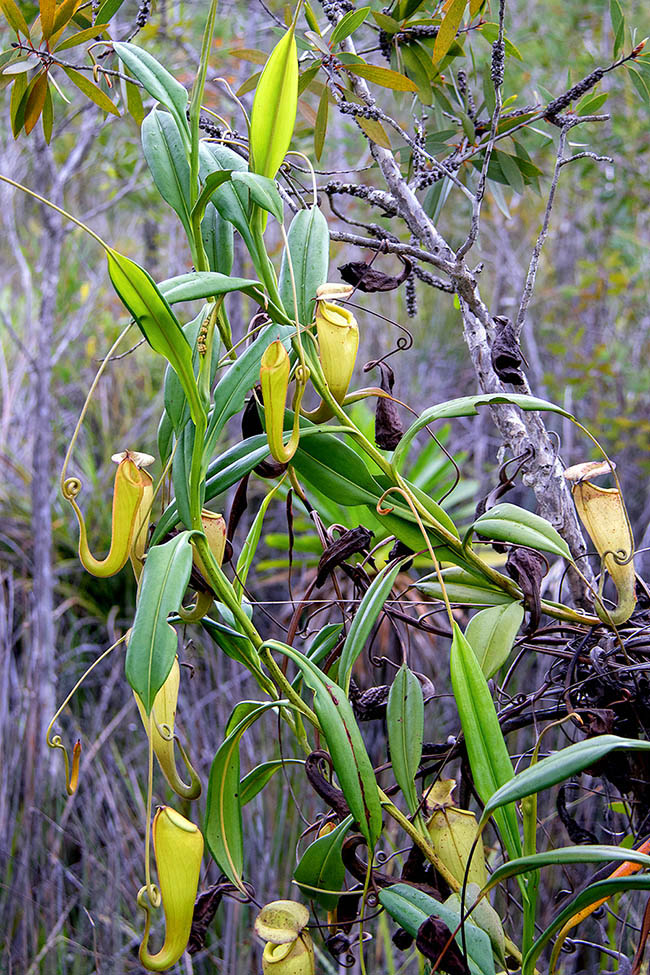
Nepenthes madagascariensis has a 1,5 m stem, but finding a support turns climber and reaches 9 m © Tore Berg
The opening of the ascidium faces outwards whilst the extension of the leaf forms a spiral to act as shock absorber or also for rolling up around the branches giving stability to the ascidium itself. The peristome, thanks to attracting colours and odours, manages to bring the preys closer that, when in contact with the waxy area, slide inside.
The inner superior part of the ascidia is formed by very small scales that prevent preys from climbing outwards, in fact they make them slide into the low part where the digestive liquid is located.
The inner zone is covered by small glands that secrete the digestive liquid with which the plant will be able to liquefy the victims. The same glands have the function of reabsorbing the dissolved preys.
It has been noted that the inferior ascidia catch ants and the upper ones, usually, flying insects visiting the flowers.
The insects are attracted by the colour of the ascidium, by the nectar secreted around its opening and the smell of the fluid. In the inferior ascidia have been found coleoptera, diptera and lepidoptera. The secreted nectar, especially in the peristome and under the lid, for many of these species is the main attraction that as soon as reached, most likely, fall into the ascidia. It has been also noted that some carnivorous species of coleoptera are not attracted by the nectar, but by other insects feeding on the same.
A specific study has found that totally 94,3% of the preyed animals belong to three taxa: Formicidae (80,2%), Diptera (9,7%) and Coleoptera (4,4%).
The ascidia, for about three months, are also a functional temporary habitat for various arthropods among which larvae of (Uranotaenia bosseri Grjebine, 1979, Uranotaenia belkini Grjebine, 1979), mites (Creutzeria and larvae of grass flies (Chloropidae). It has been noted that the species of Creutzeria living in Nepenthes madagascariensis, thanks to their sucker on the belly, come out through the larvae of chloropid flies that utilize the same habitat.
The volumes of the asicida vary from 17 and 493 cm3, whose medium values are of 152 cm3 in the inferior and 73 cm3, in the superior ones, but it has been proven that the different volume has no significant influence on the capture, conversely, the superior ascidia, especially during the blooming, catch much more preys belonging to taxa different than the inferior ones. Some researchers have observed that in the inner wall of the ascidia of Nepenthes madagascariensis may be found the small crab spider Synema obscuripes Dahl 1907, that seals the ascidia for building the nest. If threatened, this spider dives into the liquid of the ascidium in order to hide between the preys of the plant. After several minutes it gets out, unharmed, from the digestive liquid climbing the walls of the ascidium to continue the construction of its web.
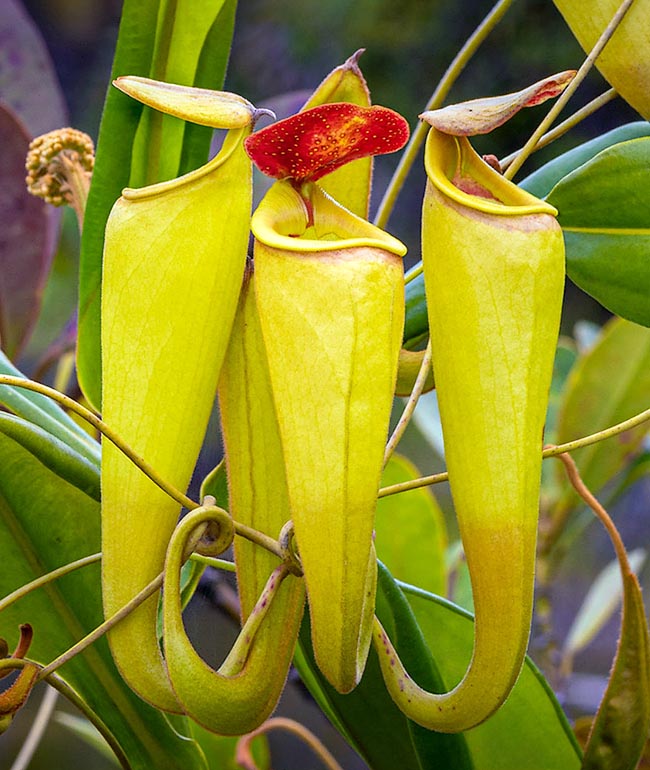
A group of ascidia displaying in transparency the digestive liquid © Tom Ballinger
A study of ethnobotany on the plants utilized by the community Mahabo-Mananivo of the region Atsimo-Atsinanana has evidenced that this plant is used for favouring the delivery and for treating malaria, filariasis, the ear infections, syphilis and gonorrhea.
Nepenthes madagascariensis is grown by the lovers of carnivorous plants of all the world. It may be reproduced by seeds, by cutting, or, by experienced persons, by meristem. It is easy to cultivate, as plain species can sometimes bear cool temperatures, even if these slow down its growth. The best results are obtained when during the day the temperature is about 21 and 32 °C and the day not under 18 °C.
This species prefers the acidic, sandy and very humid soils, accepting also the presence of the sphagnum laid on the surface of the substratum. For a good growth it is good to utilize pots homed on the bottom containing loams such as peat or a mix of loam and bark. The loam must be kept always humid and therefore the plants are to be watered from above without utilizing saucers in order to avoid stagnation of water that may cause fungal diseases.
The growth environment must have a high level of humidity (70% – 90%) and with good diffused luminosity, but never direct sunlight. If the plant under cultivation is unable to catch insects, can be administered, now and then, small doses of oxblood fertilizer or controlled-release type osmocote. In the pot is good practice to insert tutors for easing the growth of the climbing branches. In addition to fungal diseases the suffering plants can be attacked by harmful animals like scale insects, aphids and thripids. Repotting must be done only if strictly necessary.
In Madagascar, in addition to Nepenthes madagascariensis exists, of this genus, only the species Nepenthes masoalensis R.Schmid (1977) that is diffused in the eastern part of the island, in particular in Masoala Peninsula and in the region of the Ambato mountain. Observing the populations of the two species in the only one range where they are met (Masoala Peninsula) never have been observed natural hybrids. However, for a cultivation more suitable to the cold climates, artificial hybrids have been created between Nepenthes madagascariensis, that is a plain species (lowland) and Nepenthes alata Blanco that grows in a medium-high altitude (highland) and therefore is more resistant to cold in such a way that the hybrid has this characteristic. Another artificial hybrid, with the same characteristics of resistance to the low temperatures, has been obtained by crossing of Nepenthes ventricosa x Nepenthes madagascariensis.
Synonyms: Nepenthes cristata Brongn. (1824); Nepenthes madagascariensis var. cylindrica Dubard (1906); Nepenthes madagascariensis var. macrocarpa Scott Elliot (1891).
→ Per apprezzare la biodiversità all’interno della famiglia delle NEPENTHACEAE cliccare qui.
